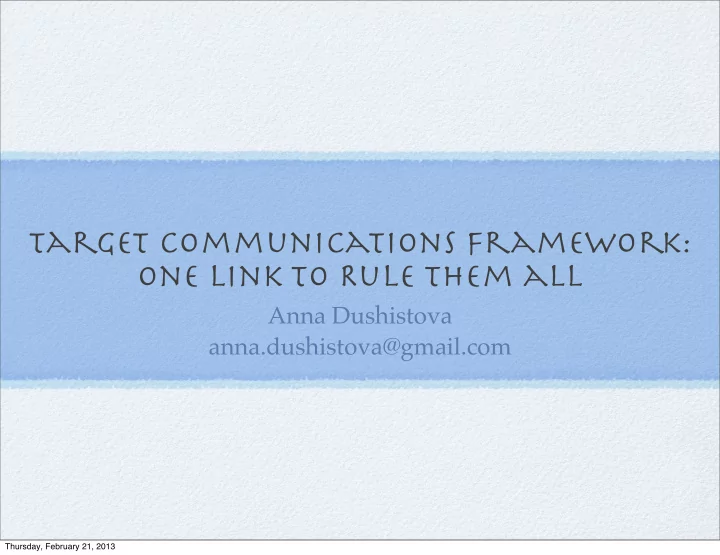

Target Communications Framework: One Link To Rule them all Anna Dushistova anna.dushistova@gmail.com Thursday, February 21, 2013
PROBLEM • Almost every device software development tool has its own method of communication with target system • Communication methods often require individual setup, configuration and maintenance, and add unnecessary constraints to the toolchain Thursday, February 21, 2013
SOLUTION “One link to rule them all, One link to find them, One link to bring them all And in the ether bind them...” Thursday, February 21, 2013
Target communications Framework Universal, extensible, simple, lightweight, vendor agnostic framework for tools and targets to communicate for purpose of debugging, profiling, code patching and performing other device software development tasks Single configuration per target (not per tool per target as today in most cases), or no configuration when possible Small overhead and footprint on target side Transport-agnostic channel abstraction Auto-discovery of targets and services Thursday, February 21, 2013
History 2007-10-25 WindRiver Systems makes initial contribution of code to the Eclipse Target Management project 2008-06-25 Initial release. Releasing core protocol documentation, initial Java framework, C agent and examples, RSE integration, and debugger integrations for CDT and TCF 2011-06-22 0.4 release. Adding Terminal service, disassembly, watchpoints. Initial addition of Python binding and Target Explorer 2012-06-27 1.0 release. Independent build and downloads. Promotion of Python binding and Target Explorer. Addition of Lua shell to agent Thursday, February 21, 2013
Thursday, February 21, 2013
Some companies behind the project Thursday, February 21, 2013
Licensing All TCF code is licensed under the Eclipse Public License (EPL) v1.0 C agent code is also licensed under the Eclipse Distribution License (EDL) v1.0 (dual- licensing) Thursday, February 21, 2013
Architecture Thursday, February 21, 2013
DEFINITIONS Peer: Communication endpoint. Both hosts and targets are called peers. A peer can act as a client or a server depending on the services it implements. Service: Group of related commands, events and their semantics define a service. A service can be discovered, added or removed as a group at a communication endpoint. Channel: Communication link connecting two endpoints (peers). A single channel may be used to communicate with multiple services. Multiple channels may be used to connect the same peers, but no command or event ordering is guaranteed across channels. Thursday, February 21, 2013
Communication Protocol Defines data packet properties and roles common for all services Defines contents of a part of a packet; the rest of the packet is treated as array of bytes Provides: Multiplexing – opening multiple channels per peer Proxy – packet forwarding on behalf of other hosts Thursday, February 21, 2013
Packet types commands (requests) ⇒ C • <token> • <service name> • <command name> • <byte array: arguments> results (responses) ⇒ N • <token> • ⇒ R • <token> • <byte array: result data> ⇒ P • <token> • <byte array: progress data> Result packets start with the string “P” for intermediate result, “R” for final result, and “N” if the command is not recognized.There should be exactly one “R” or “N” result for each command Thursday, February 21, 2013
PACKET TYPES (CONTINUED) Events ⇒ E • <service name> • <event name> • <byte array: event data> Events are used to notify clients about changes in peer state. Services should provide sufficient variety of events for clients to track remote peer state without too much polling Flow Control Events One side of communication channel might produce messages faster than they can be transmitted over the channel or can be consumed by another side. This will cause channel traffic congestion (flooding). Clients can use flow control events to implement advanced techniques to handle traffic congestion; for example, message coalescing, switching to less detailed messages, etc. ⇒ F • <int: traffic congestion level> • Thursday, February 21, 2013
AUTO-Discovery The Locator service uses the transport layer to search for peers and to collect data about the peer's attributes and capabilities (services) The only required service Thursday, February 21, 2013
What is already there? A plain-C implementation of a lightweight extendable target agent Java client API (usable standalone or on top of Eclipse) Python and Lua client APIs A complete debugger UI implementation in Eclipse A CDT integration for debugger launching A Target Management / Remote Systems Explorer integration for file system and process browsing Target Explorer – A lightweight UI for remote file system and process browsing, terminal access and debugger launch Documentation and usage examples Thursday, February 21, 2013
TCF Agent - Available services Locator Service Path Map Service Memory Service File System Service Processes Service System Monitor Service Run Control Service Terminals Service Registers Service Streams Service Stack Trace Service Disassembly Service Breakpoints Service Context Query Service Memory Map Service Thursday, February 21, 2013
Demo SETUP Host: Yocto standalone cross toolchain 1.2.1 for x86(32 bit) Eclipse IDE for C/C++ Developers package Juno SR2 Target(qemu x86): Stable kernel 3.6.2 from kernel.org Yocto core-image-sato-sdk filesystem image for x86 qemu Latest TCF agent Thursday, February 21, 2013
Thursday, February 21, 2013
Thursday, February 21, 2013
References http://wiki.eclipse.org/TCF http://git.eclipse.org/c/tcf/ org.eclipse.tcf.git/plain/docs/ tcf-dev mailing list: http://dev.eclipse.org/ mhonarc/lists/tcf-dev/ Thursday, February 21, 2013
Thursday, February 21, 2013
Thursday, February 21, 2013
Recommend
More recommend